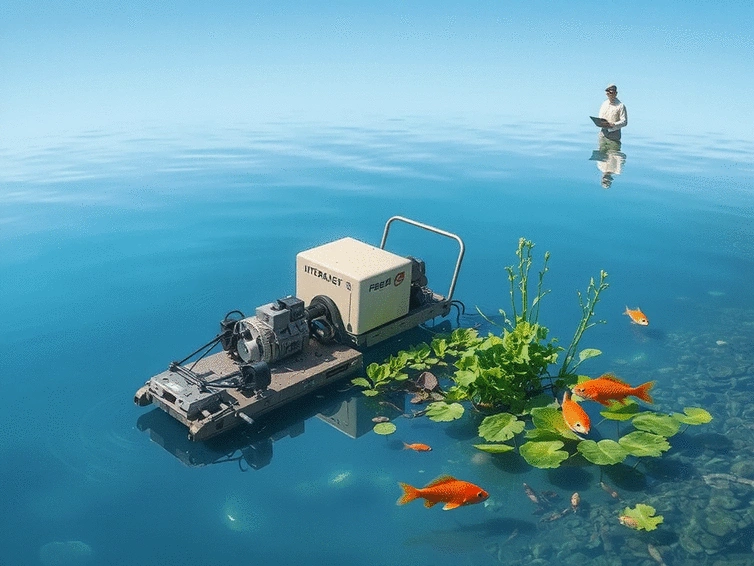
Integrated Approaches to Aquatic Weeds
What if the very weeds that disrupt our water ecosystems also hold the key to their restoration? Understanding Integrated Aquatic Weed Management (IAWM) not only promotes ecological balance but empowers communities to reclaim their waterways. Here’s what you’ll learn about managing aquatic weeds effectively.
What You Will Learn
- IAWM is a comprehensive approach that combines mechanical, biological, and chemical methods for effective weed control.
- Using multiple strategies enhances effectiveness, reduces resistance, and promotes ecological balance.
- Aquatic weeds can significantly impact ecosystem health, causing oxygen depletion and murky water.
- Sustainable practices, such as community engagement and regular monitoring, are essential for long-term success in aquatic management.
- Climate change is altering aquatic ecosystems, necessitating flexible management strategies to adapt to new challenges.
Integrated Aquatic Weed Management: A Multi-faceted Approach
This visual illustrates the core components and key benefits of Integrated Aquatic Weed Management (IAWM), highlighting its holistic nature and positive ecosystem impacts.
Core IAWM Strategies
- • Mechanical Control
- • Biological Control
- • Chemical Control
(Combined for optimal results)
Key Benefits of Integration
- ✓ Enhanced Effectiveness
- ✓ Reduced Resistance
- ✓ Ecological Balance
(Promoting healthier aquatic ecosystems)
Impact of Unmanaged Weeds
- ↓ Oxygen Depletion
- ↓ Reduced Water Clarity
- ↓ Recreational Impact
(Harmful to ecosystems & human activities)
Sustainable Practices
- ✓ Regular Monitoring
- ✓ Community Engagement
- ✓ Education & Training
(Fostering long-term ecological balance)
Understanding Integrated Aquatic Weed Management Strategies
As we delve into the world of Integrated Aquatic Weed Management (IAWM), it’s crucial to grasp what this approach entails. IAWM is a holistic strategy that combines various methods to effectively control and manage aquatic weeds. Rather than relying on a single solution, it integrates mechanical, biological, and chemical strategies to address the complexities of waterway management.
This comprehensive approach not only enhances the effectiveness of weed control but also promotes ecological balance. By using IAWM, we can ensure that our waterways remain healthy and vibrant, supporting both aquatic life and human activities.
What is Integrated Aquatic Weed Management?
Integrated Aquatic Weed Management refers to a set of practices designed to manage aquatic weeds in a sustainable manner. It involves the careful selection and combination of various control strategies tailored to specific environments and circumstances. At Aquatic Weed Solutions, we emphasize the importance of understanding local conditions, as they significantly influence the success of chosen methods.
- Mechanical Control: Using physical methods to remove or suppress weeds.
- Biological Control: Introducing natural predators or biocontrol agents to manage weed populations.
- Chemical Control: Applying herbicides responsibly to target specific weed species.
Each of these methods can stand alone, but their true power lies in their combination. By integrating these strategies, we create a more resilient management plan that can adapt over time. For more in-depth information on the principles guiding such management, you can refer to resources on integrated weed management.

Importance of Combining Mechanical, Biological, and Chemical Methods
Combining different methods in managing aquatic weeds is not just a strategy; it’s a necessity! Each method has its strengths and weaknesses, and relying on one alone often leads to inconsistent results. For instance, while mechanical removal can be effective in small areas, it may not address underlying issues that contribute to weed growth.
- Enhanced Effectiveness: Using multiple methods can target different life stages of weeds.
- Reduced Resistance: A varied approach minimizes the chance of weeds developing resistance to any single method.
- Ecological Balance: Integrating strategies promotes a healthier aquatic ecosystem.
By understanding these benefits, we can tailor our management efforts to not only remove unwanted weeds but also foster a thriving aquatic environment. Research on integrated pest management strategies in aquatic systems further supports this multi-pronged approach.
Impact of Aquatic Weeds on Ecosystem Health and Water Quality
Aquatic weeds can have a profound impact on ecosystem health and water quality. When left unmanaged, these invasive plants can choke waterways, disrupt food chains, and decrease biodiversity. I've seen firsthand how a single invasive species can alter the habitat, making it less hospitable for native wildlife!
- Oxygen Depletion: Dense weed growth can deplete oxygen levels, harming fish and other aquatic life.
- Water Clarity: Weeds can contribute to murky waters, affecting photosynthesis in underwater plants.
- Recreational Impact: Overgrown waterways can limit recreational activities like fishing, swimming, and boating.
Understanding these impacts is vital for anyone managing aquatic ecosystems. By implementing integrated management strategies, we can combat these challenges and work towards healthier waterways. The importance of these strategies is highlighted in studies on the impact of alien aquatic plants on water quality.
Pro Tip
Did you know? Regularly rotating between different control methods can significantly increase your effectiveness in managing aquatic weeds. This practice not only targets diverse growth stages but also helps prevent the development of resistance in weed populations. Staying informed about the latest research and techniques can further enhance your approach!
Frequently Asked Questions about Integrated Aquatic Weed Management
What is Integrated Aquatic Weed Management (IAWM)?
IAWM is a comprehensive approach that combines various control methods—mechanical, biological, and chemical—to effectively manage aquatic weeds in a sustainable manner. It aims to achieve long-term control while promoting ecological balance.
Why is it important to combine different weed control methods?
Combining methods enhances overall effectiveness by targeting different life stages of weeds, reduces the likelihood of weeds developing resistance to a single method, and fosters a healthier aquatic ecosystem by balancing various impacts.
How do aquatic weeds impact ecosystem health?
Unmanaged aquatic weeds can lead to oxygen depletion, harming fish and other aquatic life. They can also reduce water clarity, impede photosynthesis, and negatively affect recreational activities like fishing and swimming.
What are some sustainable practices in aquatic management?
Sustainable practices include regular monitoring of weed populations for early intervention, engaging local communities to foster ownership, and providing education and training to make informed management decisions.
How does climate change affect aquatic weed management?
Climate change can lead to increased invasiveness of certain weed species due to warmer waters, alter water quality through changing precipitation patterns, and shift native species distribution, all of which complicate management efforts and require adaptable strategies.
Summarizing the Benefits of Integrated Aquatic Weed Management
Effective integrated aquatic weed management isn’t just a method; it’s a holistic approach that benefits both ecosystems and communities. By combining multiple strategies, we create a robust framework for managing aquatic weeds that aligns with ecological principles. This integrated approach fosters healthier water habitats, enhances biodiversity, and supports the overall health of aquatic ecosystems.
Here are some key takeaways for effective weed control:
- Holistic Approach: Integrating mechanical, biological, and chemical methods ensures comprehensive control.
- Enhanced Ecosystem Resilience: Healthy ecosystems can recover more quickly from disturbances.
- Cost-Effectiveness: Preventative management strategies can reduce long-term costs associated with severe infestations.
It’s clear that when we strategically implement these practices, the benefits extend beyond simple control. They lead to sustainable environments that can support both aquatic life and human communities.
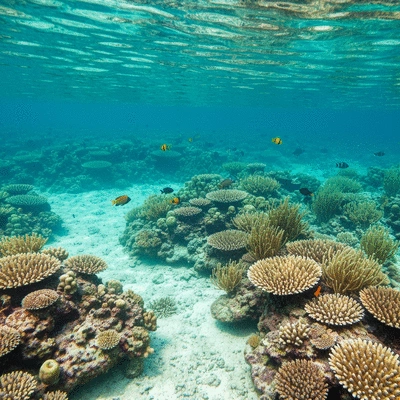
Encouraging Sustainable Practices for Aquatic Health
At Aquatic Weed Solutions, we emphasize the importance of sustainable practices in every management strategy. Encouraging landowners, ecologists, and waterway managers to adopt these practices not only improves immediate management outcomes but also nurtures long-term ecological balance. Here are some practices to consider:
- Regular Monitoring: Keeping an eye on aquatic weed populations allows for early interventions.
- Community Engagement: Involving local stakeholders fosters a sense of ownership and responsibility.
- Education and Training: Providing resources and training helps individuals make informed management decisions.
By integrating these sustainable practices, we can effectively combat invasive species while promoting the health of our aquatic environments. Together, we can work towards a future where our waterways thrive!
Impact of Climate Change on Aquatic Management Strategies
Climate change poses significant challenges to aquatic management. As temperatures rise and weather patterns shift, we are witnessing alterations in aquatic ecosystems. Some of these changes include:
- Increased Invasiveness: Warmer waters can encourage the growth of invasive species, complicating management efforts.
- Altered Water Quality: Changing precipitation patterns may affect nutrient levels and pollution concentrations in waterways.
- Shifts in Native Species: Climate change can impact the distribution of native plants and animals, further challenging ecosystem balance.
As we navigate these challenges, it’s essential to adapt our management strategies. By staying informed and flexible, we can mitigate the impacts of climate change on our precious aquatic resources.
Taking Action: Implementing Integrated Strategies
Resources for Further Learning and Support
To thrive in the management of aquatic weeds, it’s crucial to tap into available resources. Aquatic Weed Solutions offers a wealth of information, including:
- Illustrated Guides: Easy-to-follow resources for species identification.
- Management Techniques: Practical tips for effective weed control.
- Research Articles: Up-to-date studies on aquatic ecosystems and management practices.
These resources empower individuals and communities to take informed action against aquatic weeds.
Engaging with Community Initiatives for Aquatic Management
Engagement is key! Participating in local initiatives can significantly enhance your aquatic management efforts. Look for opportunities to get involved, such as:
- Local Workshops: Gain hands-on experience and learn from experts in the field.
- Volunteer Programs: Join community efforts to clean and restore waterways.
- Online Forums: Connect with others facing similar challenges and share successful strategies.
By engaging with these initiatives, we foster a collaborative spirit that enhances our community's overall aquatic health.
Education and Outreach: Fostering Public Awareness on Aquatic Issues
Public education is a cornerstone of effective aquatic management. At Aquatic Weed Solutions, we strive to raise awareness about the challenges posed by aquatic weeds and the importance of preserving our ecosystems. Here are a few outreach strategies:
- Workshops and Seminars: Share knowledge through interactive learning experiences.
- Social Media Campaigns: Utilize platforms to spread information and engage a broader audience.
- Collaborations with Schools: Partner with educational institutions to educate younger generations about aquatic ecosystems.
By fostering public awareness, we can inspire collective action toward healthier and more resilient aquatic environments. Let's work together to protect the beauty and integrity of our waterways!
Recap of Key Points
Here is a quick recap of the important points discussed in the article:
- Integrated Approach: Utilize mechanical, biological, and chemical methods together for effective aquatic weed management.
- Ecological Balance: Combining strategies not only controls weeds but also promotes a healthier aquatic ecosystem.
- Regular Monitoring: Keep track of aquatic weed populations for timely interventions and effective management.
- Community Engagement: Involve local stakeholders in management efforts to foster responsibility and awareness.
- Sustainable Practices: Encourage practices that support long-term ecological balance and resilience in aquatic environments.

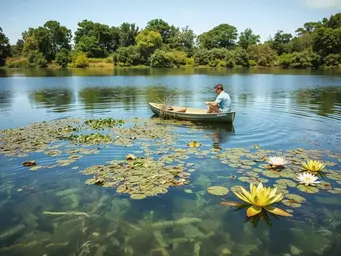

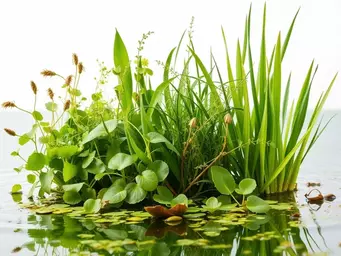
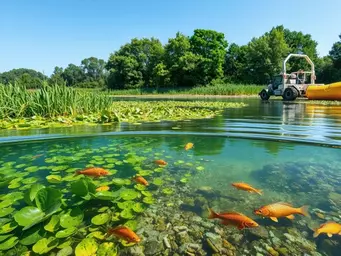
Managing Aquatic Weeds Effectively
Impact of Aquatic Weeds on Recreation
Understanding Aquatic Weed Varieties
Integrated Aquatic Weed Management Methods
Integrated Approaches to Aquatic Weeds